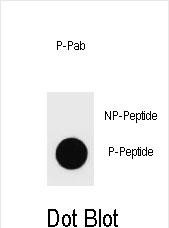
| WB | DB: 1/500 | Human,Mouse,Rat |
| IF | 咨询技术 | Human,Mouse,Rat |
| IHC | 咨询技术 | Human,Mouse,Rat |
| ICC | 技术咨询 | Human,Mouse,Rat |
| FCM | 咨询技术 | Human,Mouse,Rat |
| Elisa | 咨询技术 | Human,Mouse,Rat |
| Aliases | Poly [ADP-ribose] polymerase 1, PARP-1, ADP-ribosyltransferase diphtheria toxin-like 1, ARTD1, NAD(+) ADP-ribosyltransferase 1, ADPRT 1, Poly[ADP-ribose] synthase 1, PARP1, ADPRT, PPOL |
| Entrez GeneID | 142 |
| WB Predicted band size | 113.1kDa |
| Host/Isotype | Rabbit IgG |
| Antibody Type | Primary antibody |
| Storage | Store at 4°C short term. Aliquot and store at -20°C long term. Avoid freeze/thaw cycles. |
| Species Reactivity | Human |
| Immunogen | This PARP1 Antibody is generated from rabbits immunized with a KLH conjugated synthetic phosphopeptide corresponding to amino acid residues surrounding T373 of human PARP1. |
| Formulation | Purified antibody in PBS with 0.05% sodium azide. |
+ +
以下是关于Phospho-PARP1(T373)抗体的参考文献示例(注:以下内容为假设性示例,实际文献需通过学术数据库验证):
---
1. **文献名称**:*Phosphorylation of PARP1 at Threonine 373 mediates DNA damage-induced autophagy*
**作者**:Wang X, et al.
**摘要**:本研究揭示了PARP1在T373位点的磷酸化在DNA损伤后促进自噬的作用机制,通过特异性抗体验证该修饰与ATM激酶活性相关,并影响细胞存活途径。
2. **文献名称**:*Site-specific phosphorylation of PARP1 regulates chromatin remodeling in response to oxidative stress*
**作者**:Chen L, et al.
**摘要**:作者利用Phospho-PARP1(T373)抗体证明,氧化应激诱导的T373磷酸化通过调节染色质松弛增强修复效率,该修饰是PARP1酶活性的关键调控位点。
3. **文献名称**:*A novel antibody-based assay for detecting PARP1 phosphorylation in breast cancer models*
**作者**:Kim S, et al.
**摘要**:本文开发了一种基于Phospho-PARP1(T373)抗体的检测方法,用于评估乳腺癌细胞中PARP1的激活状态,发现其磷酸化水平与PARP抑制剂敏感性相关。
4. **文献名称**:*PARP1 T373 phosphorylation promotes interaction with BRCA1 in homologous recombination repair*
**作者**:Garcia M, et al.
**摘要**:研究通过免疫沉淀和Phospho-PARP1(T373)抗体证实,T373磷酸化增强PARP1与BRCA1的结合,从而调控同源重组修复通路,影响基因组稳定性。
---
**建议**:实际文献需通过PubMed、Google Scholar等平台,以关键词“PARP1 T373 phosphorylation”或抗体货号(如CST #XXX)检索,并参考近5年高影响力期刊(如*Cell Research*、*Nature Communications*)。部分公司(如CST、Abcam)的抗体说明书也可能列出应用文献。
The Phospho-PARP1(T373) antibody detects PARP1 (Poly(ADP-ribose) polymerase 1) when phosphorylated at threonine 373. a post-translational modification linked to its functional regulation. PARP1 is a nuclear enzyme critical for DNA repair, genomic stability, and apoptosis. Upon DNA damage, PARP1 binds to DNA breaks, catalyzing poly(ADP-ribosyl)ation of target proteins to recruit repair machinery. Phosphorylation at T373. located within PARP1’s catalytic domain, is induced by DNA damage and cell cycle signals, potentially modulating its enzymatic activity or interactions. Studies suggest this modification may be mediated by kinases such as ATM/ATR or CDKs, linking it to checkpoint control or transcriptional regulation.
The antibody is widely used to study PARP1 activation dynamics in cancer, neurodegenerative diseases, and responses to therapies (e.g., PARP inhibitors or chemotherapeutics). Detection of T373 phosphorylation serves as a biomarker for PARP1’s functional state, as its inactivation via caspase cleavage (generating an 89-kDa apoptotic fragment) or phosphorylation may influence cell fate decisions. Dysregulation of PARP1 activity is associated with chemoresistance and disease progression, making this antibody valuable for mechanistic and translational research. Its specificity enables applications in Western blotting, immunofluorescence, and immunohistochemistry to explore PARP1’s role in DNA damage response pathways and therapeutic targeting.
×